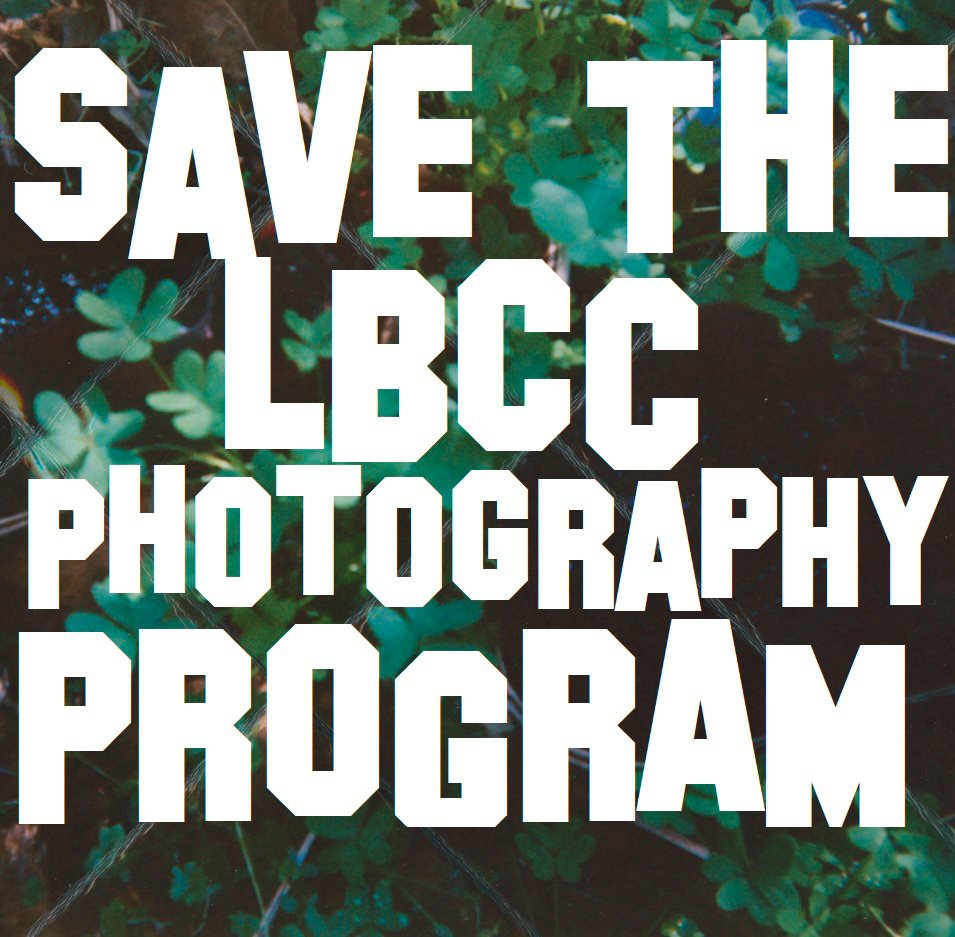
This month, Ann Mitchell, a professor of photography at Long Beach City College (LBCC) will attend a meeting which she was invited to by LBCC’s new Vice President of Academics, Gaither Lowenstein.
 The discussion? The possible liquidation of the college’s entire photography program and why it, among a list of some eighteen other programs, are about to be cut—which explains why the Photography Department will holding a rally in support of keeping the department alive.
The discussion? The possible liquidation of the college’s entire photography program and why it, among a list of some eighteen other programs, are about to be cut—which explains why the Photography Department will holding a rally in support of keeping the department alive.
“Cut” should not be taken lightly: it means the classes are essentially wiped from the books, the program will no longer be offered to students, and anyone who teaches the class or staffs the labs involved will lose their position if they do not have another area of teaching in which they partake. Three weeks after this initial meeting, Mitchell and her fellow photography educators will have to return to present plans to counteract and resolve the proposed cut.
And of course, this is nothing new. “Program Discontinuance,” as it is referred to, has existed in the past. However, it was geared towards specifically troubled programs, such as ones with low enrollment rates or academic deficiencies, and held over a multi-year process that deeply analyzed the program’s “educational vitality,” as Mitchell put it.
This go-round is mightily different, reducing the systematic elimination of programs to a four-month process that will end in January.
Following a deficit such as the ones that hit colleges across California earlier this year, a college has two options, Mitchell explained to the Post.
“On one hand, you can preserve the diversity of the college offerings and reduce classes—this means cut part-time faculty—throughout the college. This was the primary method that LBCC used to handle the previous cuts [with former VP of Academics, Don Berz]. The second method is to cut programs—this means cutting full-time faculty and staff—and it accompanies a shift in the college to a less diverse set of offerings. This is the method preferred by our new VP.”
Strangely, this latter approach seems antithetical to higher education, which is supposed to be focused on area-specific knowledges—such as welding or recording arts, two other programs on the cutting board—in order to hone a student’s specific skills and interests. The more you offer, the wider and more well-rounded student populace you attract, thereby creating a more vibrant campus.
“We’re a bit unsure of what it means for the students currently in the program,” Mitchell said.
This point is critical, given many students at LBCC plan to transfer to Long Beach State (CSULB) due to not only their desire to remain within the area, but the ease of access to certain specialty programs. LBCC’s arts and trade programs are often coordinated with that of CSULB, thereby permitting students to transfer without losing any or some credits. While eliminating programs such as photography will allow the school to offer more core classes (such as English and math) needed for general transfer requirements, it would effectively shut off students hoping to take advantage of these coordinated transfers to CSULB.
This also dampens the strengthening of the program that has, over the last few years, gotten them to the point “where we’ve got a very committed group of people there”—as well as its initiative with other arts/trades programs to be collaborative, where students venture into multiple areas of the commercial arts.
“We feel that this mixed discipline approach is what is needed for the new marketplace. Photographers now need a mix of skills: lighting, composition, video, editing, animation, et cetera, to make them competitive,” Mitchell stated.
As to other ways in which Mitchell and her cohorts help to save the program, they are big albeit essential steps involving smaller, more targeted certificates in photography as well as mobilizing past and current students to help spread the word of the program’s possible liquidation.
“My problem with that is many students need the arts/trades as their gateway into higher education,” Mitchell explained. “I’ve seen it over and over, students who find themselves in the arts and then can continue with their education in a meaningful way. This also will mean that if the commercial arts are disappearing from the public colleges (and aren’t emphasized at the 4 years), then the only choice is private schools and they’re extremely expensive. Having a career in the creative arts is much more possible when you don’t have a large debt load.”
The rally will be held 4:45PM on Tuesday, September 25 at the Liberal Arts Campus (LAC), T Building, Room 1100. Organizers of the rally are asking supporters to wear a black shirt with camera in hand.
The other programs proposed for the cutting floor are: Air Conditioning; Auto Mechanics; Auto Body; Aviation Maintenance; Carpentry; Computer Proficiency for Academic Success (CPAS); Diagnostic Medical Imaging (DMI); Diesel Mechanics; Film; Human Services (Alcohol/Drug); Interior Design; Medical Assisting; Photography; Physical Geography; Radio/TV; Recording Arts; Real Estate; Sheet Metal; and Welding.
Visit Save the LBCC Photography Program on Facebook.
{vsig}trevor/lbccphoto{/vsig}
Students learning the process of making lumenprints in Brian Doan’s Introduction to Black and White Photography class at Long Beach City College. Photos by Trevor Roberson, Long Beach Post staff photographer and LBCC Photography student.

